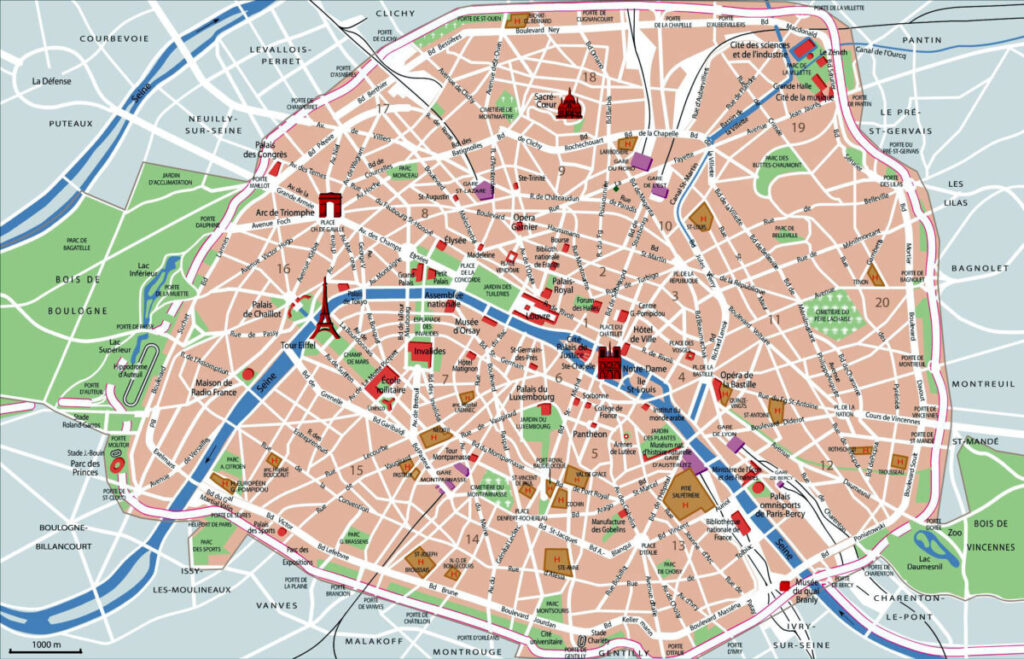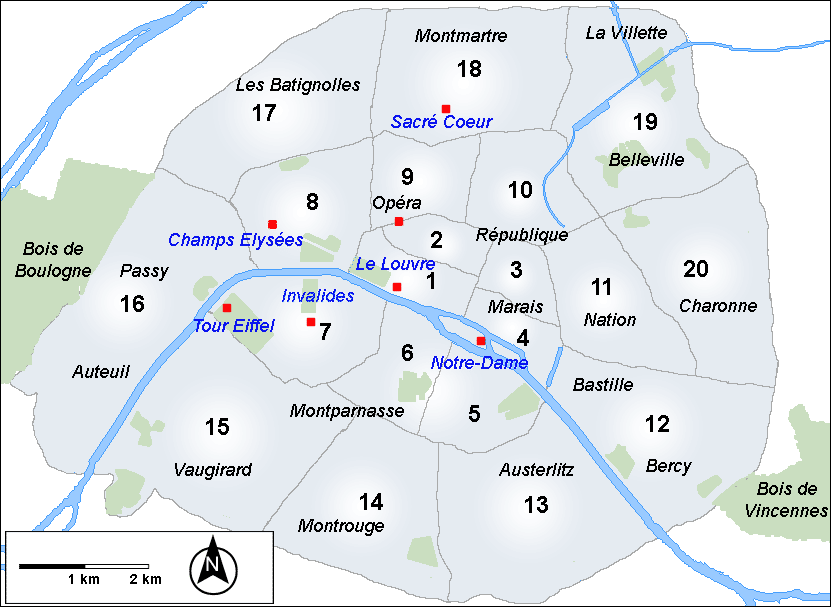Paris Sighseeing Map
Paris is a tight circle on the map, yet inside it lies an entire world of history, culture, and neighborhoods. The city is officially divided into 20 arrondissements, spiraling out like a snail from the Louvre. Each one has its own identity. Looking at the map, you can see how the Seine runs like a spine through the middle, with bridges tying together the Right Bank, the Left Bank, and the islands.
1st Arrondissement: The Historic Core
At the very center stands the Louvre Museum, once a royal palace, now home to one of the world’s most famous art collections. Just outside is the Tuileries Garden, stretching toward Place de la Concorde. Across Rue de Rivoli sits the Palais Royal, with its arcades and striped Buren columns. This arrondissement is compact, but it’s where Paris began to expand into the grand city we know.
2nd Arrondissement: Covered Passages and Commerce
North of the Louvre lies a smaller district full of covered passages like Galerie Vivienne. The 2nd also houses the Bourse de Paris (old stock exchange) and narrow streets lined with cafés and restaurants. It’s less monumental than the 1st, but rich in daily Parisian life.
3rd Arrondissement: The Upper Marais
This area holds the northern half of the Marais district, where you find historic mansions converted into museums, such as the Musée Carnavalet and Musée Picasso. The streets here feel more residential, though they’re busy with galleries, bakeries, and boutiques.
4th Arrondissement: Notre-Dame and Île Saint-Louis
The 4th is anchored by Notre-Dame Cathedral on Île de la Cité. Next door is Sainte-Chapelle, famous for its stained glass. Walk east and you reach Île Saint-Louis, quieter and elegant. On the Right Bank side sits Place des Vosges, one of the city’s most beautiful squares.
5th Arrondissement: The Latin Quarter
The Left Bank begins with the 5th, home to the Panthéon, the Sorbonne, and winding medieval lanes. Rue Mouffetard runs like a market street through the quarter. Students still fill its cafés and bookshops, keeping the academic spirit alive.
6th Arrondissement: Saint-Germain and the Luxembourg
This arrondissement mixes elegance with green space. The Luxembourg Gardens spread across the heart of the district, while streets like Boulevard Saint-Germain are lined with legendary cafés such as Café de Flore and Les Deux Magots. It’s a polished yet lively corner of Paris.
7th Arrondissement: The Eiffel Tower and Invalides
The city’s most recognized landmark, the Eiffel Tower, rises from the Champ de Mars in the 7th. A short walk brings you to Les Invalides, where Napoleon’s tomb rests under the golden dome. The area is also filled with ministries and embassies, reflecting its role in French political life.
8th Arrondissement: Champs-Élysées and Arc de Triomphe
The wide boulevard of the Champs-Élysées runs straight toward the Arc de Triomphe, anchoring the west side of Paris. At the other end, the Place de la Concorde connects back to the Louvre axis. Luxury shops, hotels, and theaters cluster here, making it one of Paris’s most famous addresses.
9th Arrondissement: Opera and Department Stores
The highlight here is the Palais Garnier, the grand opera house. Nearby, the Grands Boulevards host department stores like Galeries Lafayette and Printemps. The area mixes Haussmann boulevards with side streets full of restaurants and theaters.
10th Arrondissement: Canal and Stations
Two major train stations—Gare du Nord and Gare de l’Est—stand in the 10th. But it’s also where you’ll find the Canal Saint-Martin, a favorite promenade with iron footbridges, bars, and cafés along the water.
11th Arrondissement: Bastille to Oberkampf
Once an industrial quarter, the 11th is now buzzing with nightlife. The Place de la Bastille marks its western edge, while Rue Oberkampf draws crowds for its bars and music venues. It’s a district where Parisian evenings stretch late.
12th Arrondissement: East Gate and Green Space
On the eastern side, the 12th is home to the Gare de Lyon and the modern Opéra Bastille. It also borders the Bois de Vincennes, one of Paris’s largest parks, where you’ll find a medieval château, zoo, and lakes.
13th Arrondissement: Modern Towers and Chinatown
The 13th is known for its high-rise towers and broad avenues. It’s also the heart of Paris’s Chinatown, with Asian restaurants and supermarkets concentrated around Avenue d’Ivry and Avenue de Choisy. Along the Seine, the Bibliothèque François Mitterrand stands as a modern landmark.
14th Arrondissement: Montparnasse
Montparnasse once drew artists like Hemingway and Picasso. Today the Montparnasse Tower dominates the skyline with its observation deck. The Catacombs of Paris, a vast underground ossuary, also lie beneath this arrondissement.
15th Arrondissement: Residential Paris
The 15th is one of the city’s most populated arrondissements. It’s largely residential, though the Parc André Citroën and the edge of the Eiffel Tower area fall here. The Porte de Versailles Exhibition Center also attracts international fairs and events.
16th Arrondissement: Western Elegance
To the west, the 16th is filled with broad avenues, embassies, and private mansions. The Palais de Chaillot faces the Eiffel Tower across the Seine, while the district stretches out toward the Bois de Boulogne, a massive park with lakes, gardens, and the Roland-Garros stadium.
17th Arrondissement: Mixed Paris
The 17th transitions from the chic Parc Monceau district to working-class Batignolles. It borders the Arc de Triomphe to the south and spreads north into quieter neighborhoods.
18th Arrondissement: Montmartre
Crowning the northern skyline is the Sacré-Cœur Basilica. The steps below offer panoramic views over Paris. Around it, Montmartre still feels like a village, with cobbled lanes, vineyards, and the Place du Tertre where artists sketch portraits.
19th Arrondissement: Northeast Parks and Culture
The 19th is green and cultural. It holds the Parc des Buttes-Chaumont, one of the city’s most dramatic parks with cliffs and a temple, and the Parc de la Villette, home to the Cité des Sciences and concert halls like the Philharmonie.
20th Arrondissement: Belleville and Père Lachaise
On the far eastern edge lies Père Lachaise Cemetery, where Chopin, Jim Morrison, and Edith Piaf rest. The district also covers Belleville, a lively neighborhood with street art, immigrant communities, and a park that gives views over the city.
The Green Borders: Paris’s Two Great Parks
The map shows two enormous green spaces anchoring the city. The Bois de Boulogne in the west and the Bois de Vincennes in the east are like lungs for Paris. Each is larger than Central Park in New York and offers space to cycle, row boats, or wander through gardens.
Reading the Map
The Seine is the main guide. Landmarks along its curve – from the Louvre and Orsay to the Eiffel Tower – define central Paris. The snail-shell numbering of arrondissements helps you orient yourself quickly: single-digit numbers mean you’re central; higher numbers take you to the edges.


